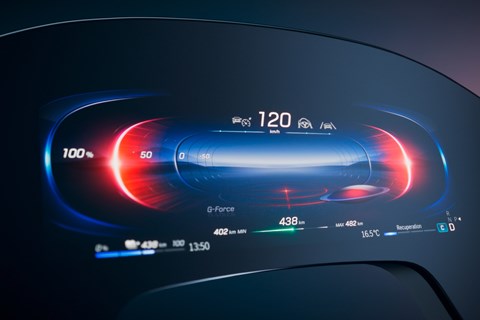► MBUX Hyperscreen explained
► Details of infotainment's evolution
► To debut in new EQS electric saloon
Mercedes’ MBUX infotainment system has evolved once again, as the brand unveils its new MBUX Hyperscreen, set to make its debut on the new Mercedes EQS.
Since 2018, the brand’s slick and connected infotainment has incorporated itself into almost all of the brand’s models, both passenger and commercial. Towards the end of 2020, we saw the rise of ‘My MBUX’ with the new S-Class, introducing new features like 3D-effect dials, an augmented-reality head-up display and biometric security.
As Mercedes gears up for introducing its all-electric flagship, the EQS, later in 2021, the brand is teasing us first with its version of the MBUX technology.
Mercedes' electric plans explained
Cool name…
And quite the piece of kit. Three OLED screens (one for the driver’s instruments, one large central control panel and another for the passenger) are tied together in a single curved panel, with two physical air vents acting as bookends. Mercedes says the third screen designed for the front passenger only activates when someone occupies the seat; the display turns into a decorative graphic otherwise.

Mercedes MBUX augmented-reality nav: does it work?
The panel is 141cm wide and is double coated with a solution that is designed to reduce both glare from sunlight and fingerprint marks. Haptic feedback is incorporated, too, with 12 actuators beneath the touchscreen. Mercedes says that key controls and switches (if you could call them that) aren’t hidden behind menus – all of the essential functions are a single tap away.
If you want to get really nerdy, the system’s hardware includes eight CPU cores and 24GB of RAM – details with such large numbers you’d only hear about if you bought a massively powerful (and expensive) gaming PC.
So, it’s just a big screen?
Arguably, yes, but Mercedes says there’s more to it than that. Merc’s chief technical officer, Sajjad Khan, says Hyperscreen is ‘at the same time the brain and nervous system of the car.’ How? Through artificial intelligence.

The key software difference here compared to other versions of MBUX is an evolution of AI. Mercedes says the system is designed to notice patterns or habits in your driving behaviours, saying Hyperscreen has ‘context-sensitive awareness.’ While essential controls are always front and centre, certain driving behaviours or habits the car is made aware of over time will mean it starts to suggest or even perform certain functions for you before you even think about it.
Mercedes claims in some suggested use cases that the system will suggest the ‘hot stone’ massage function during winter months if it’s noticed that you regularly switch it on during that time for example. Or, if you always call someone at a certain time or on a specific day while you’re driving, it’ll remember to suggest doing that at roughly the same time again.
Mercedes MBUX voice control: does it work?
The brand also confirmed that the EQS will come with suspension that can raise itself – most likely air suspension with E-Active Body Control like the S-Class. If it notices you use the vehicle lift function over a large speed bump or over to access a steep driveway, it’ll log the GPS position and do it for you the next time you approach it.
When will Hyperscreen debut?
As we’ve mentioned, we’ll see the new infotainment system’s first application in the new EQS electric car that arrives later in 2021. As for what comes after, expect it to naturally be applied to the EQS SUV slated for 2022.
Read our Mercedes reviews here